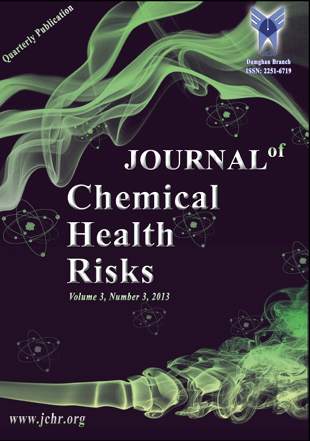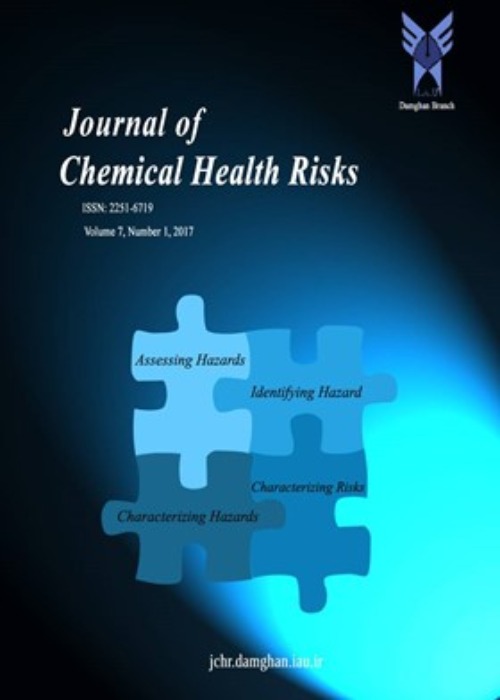فهرست مطالب

Journal of Chemical Health Risks
Volume:3 Issue: 4, Autumn 2013
- تاریخ انتشار: 1392/10/01
- تعداد عناوین: 8
-
-
Page 1Violet is one of the ornamental plants with a good value in landscaping and herbal medicine. Salicylic acid is a signaling agent involving in secondary metabolite production. The aim of this study was to evaluate the physiological responses of violet flowers to exogenous salicylic acid. This experiment was conducted in the greenhouse, as a completely randomized design. Salicylic acid was sprayed on violet plants in four levels as 0, 0.1, 0.7, 1.5 mM and three replications. Flower diameter, flower stem length, fresh weight and dry matter percentage of violet flower were measured as morphological parametes. In laboratory parameters like antioxidant activity and anthocyanin variation were recorded using spectrophotometery method. The quercetin and rutin values were determined by HPLC. Results showed that salicylic acid significantly affected on flower diameter, total antioxidant capacity, rutin and quercetin contents. Therefore data analysis provides that high levels of salicylic acid increased morphological parameters and improved chemical substance involving to secondary metabolism promotion. Furthermore, using different concentrations of the hormone is required, to achieve the best quality and quantity of plant biomass and it is also necessary to achieve the best traits of ornamental and medicinal valueKeywords: Anthocyanin, Quercetin, Rutin, Salicylic acid, Violet (Viola cornuta)
-
Page 9In the recent years, considerable attention has been allocated in the area of using natural preservatives in foods, especially vegetable oils. Starch foams prepared from high amylose starch are useful for encapsulation of substances such as chemicals, liquids or solids, including flavor compounds, pharmaceuticals and essential oils. The foams have the ability to trap the active material and subsequently release the activity. Cinnamon oil is absorbed to foam starch microparticles and acts as an antimicrobial agent. This study was designed and implemented to evaluate the use of starch foam containing vegetable oil to prevent mold growth and improve packaged bread shelf life. For this purpose, first cinnamon essential oil was extracted with water by distillation method then, 250 groups of bread were prepared within polypropylene plastic bags. Various amounts of cinnamon essential oil (500, 750, 1000and1500ppm) with 1 g of starch foam powder inside sterilized filter paper were added to these packages.The obtained results of multi-way and intergroup repeated tests indicated that there was a significant difference (P <0/05) between the control groups and various groups containing cinnamon essential oil in terms of microbial load. In the groups containing essential oils, less increase was showed in microbial load and with increasing concentrations of cinnamon essential oil, mold and yeast growth rate decreased. It concluded that by using starch foam containing cinnamon essential oil in bulky bread packing at ambient temperature (25°C), the spoilage process of bulky bread can be postponed 3 to 6 days, and it can be used as an appropriate natural and antifungal preservative in packaging of bread.Keywords: Active packaging, Antifungal activity, Bread, Cinnamon bark oil, Starch foam
-
Page 19Construction and function of effective substances of medicinal plants are influenced by environmental factors such as deficiency or increased of nutrients in the soil and substrates. Therefore, a greenhouse experiment was performed in completely randomized design with four treatments and three replications. The effects of vermicompost were examined on the morphological and phytochemical features in aloe vera. Treatments consisted of four vermicompost percentages (0%, 15%, 30% and 45%) in humus soil. The considered factors were leaf weight, gel fresh weight, gel dry weight, the antioxidant capacity of the gel, glucomannan of gel, flavonoids and phenols of gel, and anthocyanins of cortex. data analysis showed that the maximum of leaf weight, gel weight, dry weight of gel and gel glucomannan was obtained in 45% of vermicompost. The maximum of gel phenol, antioxidant activity of gel and anthocyanins of cortex belonged to 30% of vermicompost and gel flavonoid in 15% of vermicompost. To achieve maximum antioxidant capacity and optimum amount of active substances, more studies and application of different field of vermicompost are required in order to increase the value of medicinal properties.Keywords: Aloe vera, Antioxidant capacity, Glucomannan, Phenol, Vermicompost
-
Page 29In this study, a factorial experiment was performed in completely randomized design (CRD) with three factors: arbuscularmycorrhizal fungi with two levels (inoculated and non-inoculated soil) and cadmium with six levels (0, 5, 10, 20, 40 and 80 ppm). The results showed that effect of cadmium levels on iron and manganese concentration was significant in one percent level of statistical. In80 ppm cadmium concentration in soil, a reducediron were on concentration of Iron (39% and 53%) and manganese (48% and 48.5%) in root and aerial respectively. Butarbuscularmycorrhiza fungi increasediron concentration 30.2% and 26.7% in theroot and aerial, and manganese concentration36% and 30.9% in root and aerial plant respectively.Keywords: Arbuscularmycorrhiza, Soil contamination, Cadmium
-
Page 35A simple and sensitive, solid-phase extraction method for the removal of Citalopram drug from waste water has been developed by using magnetic nanoparticles modified with surfactant sodium dodecyl sulfate. These magnetic nanoparticles have shown great adsorptive tendency towards Citalopram drug. The effect of different parameters influencing the extraction efficiency of this drug were investigated and optimized including the pH, amount of the surfactant, contact time and temperature. The extracts were analyzed by ultraviolet spectrophotometry at 239nm. Under these conditions, the related standard deviation (RSD %) of the method at two concentrations (5 and 50µg.mL-1) was in the range of (3.14–3.75) % (n = 8). The calibration curve was linear in the range of 2-100 µg.mL-1 of Citalopram drug with a correlation coefficient of >0.99.Keywords: Fe3O4 magnetic nanoparticles, Citalopram hydrobromide, Waste water, Solid, phase micro extraction, UV, spectrometry
-
Page 43The water-distilled essential oils, which were obtained from the fresh aerial parts of Satureja hortensis were analyzed by means of GC and CC/MS instruments. The plant was collected during the flowering stage from Foroomad Mountains, Semnan Province, and heart of Iran. Twenty compounds were identified in the different samples analyzed, representing 100% of the total oil contents. In terms of general categories, monoterpene hydrocarbons dominated the chemical profile of the oils with γ-terpinene (27.4%), carvacrol (23.7%), p-cymene (11.1%), α-terpinene (10.2%), α-pinene (5.1%) and myrcene (5.1%) as the main constituent components. The other constituents were found to be α-thujene (3.9%), β-pinene (3.0%), sylvestrene (3.0%), α-phellandrene (1.2%) and (-)-terpinen-4-ol (1.0%).Keywords: Satureja hortensis, Essential oil, Hydrodistillation, γ Terpinene, Carvacrol, P, cymene, Monoterpene hydrocarbons
-
Page 55An interpolation technique, ordinary Inverse Distance Weighted (IDW), was used to obtain the spatial distribution of groundwater quality parameters in Damghan plain of Iran. According to Scofield guidelines for TDS value, 60% of the water samples were harmful for irrigation purposes. Regarding to EC parameter, more than 60% of studied area was laid in bad range for irrigation purposes. The most dominant anion was Cl- and 10% of water samples showed a very hazardous class. According to Doneen guidelines for chloride value, 100% of collected water from the aquifer had slight to moderate problems for irrigation water purposes. The predominant cations in Damghan plain aquifer were according to Na+> Ca++> Mg++> K+. Sodium ion was the dominant cation and regarding to Na+ content guidelines, almost all groundwater samples had problem for foliar application. Calcium ion distribution was within usual range. The magnesium ion concentration is generally lower than sodium and calcium. The majority of the samples showed Mg++amount within usual range. Also K+ value ranged from 0.1 to 0.23 meq/L and all the water samples had potassium values within the permissible limit. Based on SAR criterion 80 % of collected water had slight to moderate problems. The SSP values were found from 2.87 to 6.87%. According to SAR value, thirty percent of ground water samples were doubtful class. The estimated amounts of RSC were ranged from 0.4-2 and based on RSC criterion, twenty percent of groundwater samples had slight to moderate problemsKeywords: GIS, Spatial analysis, Water Quality, IDW, Groundwater
-
Page 63In this work 3, 6-bis (2-[2-sulfanyl-ethylimino)-methyl]-4-(4-nitro-phenylazo)-3-metoxy-phenol) pyridazine (2) was prepared and its antibacterial properties have studied. The structures of all the newly synthesized compounds have been comfirmed by elemental analysis, IR, 1H-NMR. Anti bacterial effects of compounds (1 and 2) have been studied. Following concentrations of materials were used: a=0.005 g/ml and b=0.01 M. Study was done on two strains of S.aureus and E.coli that experiments were done in Trypticase Soy Broth (TSB) and Nutrien Agar (TSB; Difco Laboratory). It is likely that these synthetic materials exert higher antibacterial effect on gram positive bacteria in comparison with gram negative.Keywords: Schiff base, Di, azo compound, Pyridazine, AntibioticOvanilin


